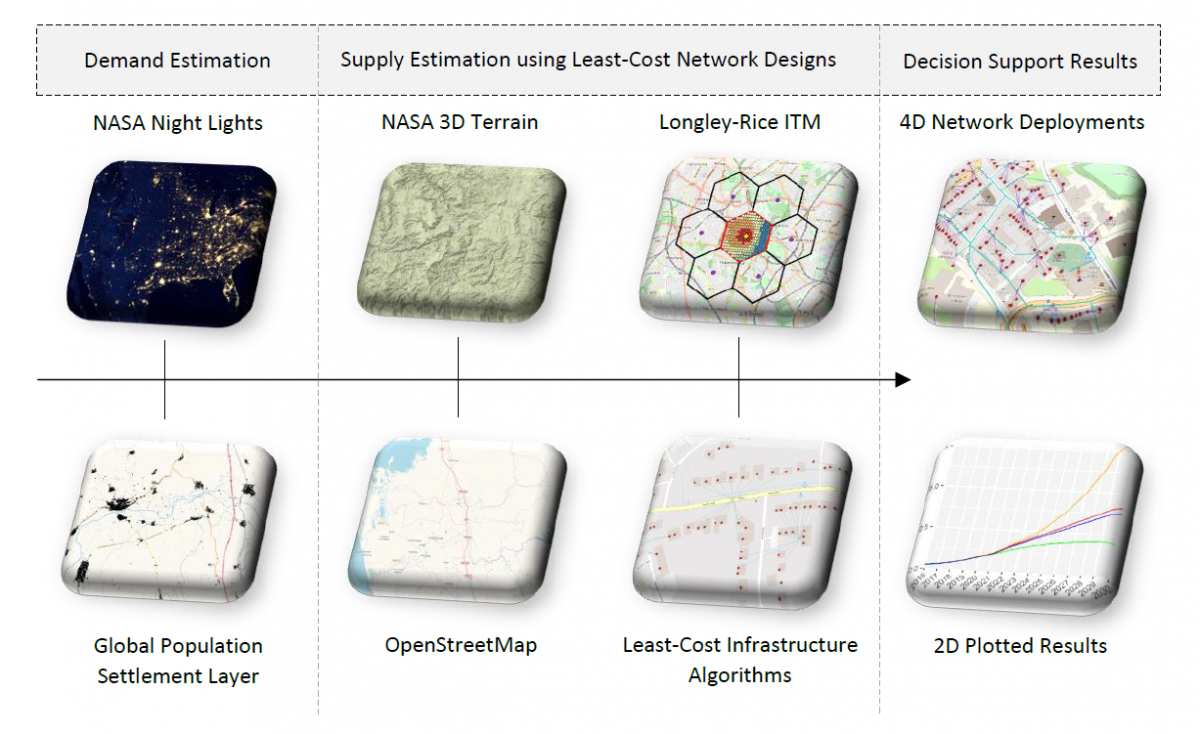Data Analytics Can Improve How We Design Broadband Strategies
Tuesday, February 16, 2021
Digital Beat
Data Analytics Can Improve How We Design Broadband Strategies

Internet access is essential for economic development and helping to deliver the United Nations Sustainable Development Goals, especially as even basic broadband can revolutionize the opportunities available to users. Yet, more than one billion people globally still live in areas without internet connectivity. Governments must make strategic choices to connect these citizens, but currently have few independent, transparent, and scientifically reproducible tools to rely on.
As part of the World Bank’s Digital Economy for Africa program, a new assessment approach has been developed to help test the effectiveness of different universal broadband strategies. For example, the United Nations Broadband Commission has been discussing setting a highly ambitious target of ensuring everyone globally has access to at least 10 Mbps by the end of this decade. While this is an admirable aim, there are few open-source tools to help understand how different decisions perform in helping to achieve this target. Traditionally, this analysis has been undertaken with spreadsheets which introduce considerable uncertainty into the results because of the many generalized assumptions involved. Figure 1 provides an example of how global data layers can be used to assess broadband strategies for any country in the world.
Figure 1 Quantifying universal broadband strategies using data analytics

The new approach takes advantage of data analytics methods to help robustly assess the effectiveness of different strategies in terms of broadband capacity, coverage, and cost. This involves two important innovations. Firstly, using remote sensing to provide high resolution estimates of broadband demand at the settlement level. Secondly, using ‘least-cost’ network designs to plan broadband networks as if the aim was to build them, enabling this information to be integrated into the assessment process to estimate capacity, coverage, and cost.
Application and Key Findings
The approach has been adapted for six East and West African countries, including Côte D’Ivoire, Mali, Senegal, Kenya, Tanzania, and Uganda. Using cellular technologies is one of the cheapest ways to provide wide-area broadband connectivity. Therefore, the aim is to assess the cost of deploying either 3G or 4G, and whether to use a fiber optic or wireless backhaul connection (to link new cell towers back into the closest fiber Point of Presence). Infrastructure sharing strategies are also explored to quantify the impact of passive or active sharing business models, along with exploring a Shared Rural Network (where active infrastructure is shared only in unviable rural locations).
The assessment finds that the cheapest deployment option is the combination of 4G with a wireless backhaul. This provides substantial evidence for those countries currently aiming to cycle through the cellular generations sequentially, to instead ‘leapfrog’ to providing 4G in underserved areas. Most of this cost saving comes from operating fewer sites, thanks to 4G being a more spectrally efficient technology, but there are also numerous benefits from having a more flexible, Internet Protocol-enabled, core network making the 4G case even more convincing. This evidence demonstrates that the technology strategy governments encourage through the regulatory landscape has a dramatic impact on the viability of universal broadband; therefore, there should be a focus on making it cheaper to deploy 4G cell sites, with more spectrum made available for wireless backhaul methods.
It is well known that governments love the revenue generated from spectrum licensing. However, in those markets where the available national revenue cannot viably support reaching universal broadband coverage, there is no net benefit from this policy approach. For example, to achieve universal broadband service in unviable national markets, if a government extracts $1 of revenue from private operators, this consequently equates to $1 of government expenditure in the form of an infrastructure subsidy to unviable areas. Therefore, in countries such as Kenya or Tanzania, it is worth rethinking spectrum licensing, potentially replacing fees with coverage obligations to push out service to unviable areas.
Infrastructure competition versus infrastructure consolidation is a perennial broadband debate. However, in extremely unviable areas the economics are far too challenging to build multiple infrastructure networks. Across the countries analyzed, site sharing and backhaul sharing strategies provide an average 33% and 55% cost saving against the baseline of each operator building their own dedicated network. However, these strategies are nationally homogenous. Therefore, one promising option is a Shared Rural Network because this approach is capable of balancing competitive markets in viable areas with enhanced sharing in unviable areas. Indeed, up to 78% of the cost saving was achieved by only sharing infrastructure in rural areas, allowing urban and suburban areas to enjoy the benefits of dynamic competition between operators. Governments should therefore undertake their own detailed assessments of infrastructure sharing in areas deemed too unviable to cover with existing terrestrial cellular business models.
For more information, see the full working paper for a detailed overview of the method and results. Additionally, the open-source code has been made freely available to access, explore and apply to any country globally.
Edward John Oughton is currently Assistant Professor of Data Analytics at George Mason University in the College of Science, having previously been a senior researcher at the University of Oxford. His current research focuses on developing open-source software to provide decision analytics for industry and government, with a particular focus on generating evidence for broadband strategies. Edward’s assessment software has been applied to over twenty countries to provide governments with quantitative evidence on the capacity, coverage, and cost of different decisions pertaining to broadband connectivity.
The Benton Institute for Broadband & Society is a non-profit organization dedicated to ensuring that all people in the U.S. have access to competitive, High-Performance Broadband regardless of where they live or who they are. We believe communication policy - rooted in the values of access, equity, and diversity - has the power to deliver new opportunities and strengthen communities.
© Benton Institute for Broadband & Society 2021. Redistribution of this email publication - both internally and externally - is encouraged if it includes this copyright statement.
For subscribe/unsubscribe info, please email headlinesATbentonDOTorg






